
The Mom Saw a Bump near Her 3-Year-Old Daughter's Eye – Then a Doctor's Call Changed Their Lives Forever
A Florida mother spent weeks trying to secure a specialist appointment for a stubborn bump on her toddler's face. When she finally got one, it led to surgery and a shocking pathology result. Within days, her daughter was in a hospital bed, fighting for her life before her fourth birthday.
Camryn had just turned three when her mother, Miranda Aldridge, first noticed a bump near her eye. It didn't hurt and didn't seem to bother her daughter, but it also didn't go away. Miranda wasn't one to overreact, but the longer it lingered, the more uneasy she became.
Doctors initially dismissed it as a minor issue, likely benign. But getting in to see a specialist proved more difficult than expected. Weeks of delays and daily phone calls followed until a last-minute appointment revealed something no one had prepared for.
What began as a cosmetic concern quickly turned into something else entirely.
In late August 2024, Miranda, a teacher in Palatka, Florida, decided to take her daughter, Camryn, to the pediatrician. For nearly a month, she had been monitoring a small bump near the toddler's eye, something that didn't seem urgent but wasn't going away either.
As time went by and nothing had changed, Miranda felt she needed clarity. The pediatrician examined Camryn and suspected it was a cyst. A referral to dermatology was submitted, and the family waited to hear back with an appointment.
When they did, they were stunned: the earliest available dermatology consultation wasn't until April 2025, eight months away. "We couldn't believe it," Miranda later shared. "It just didn't seem right to wait that long for a child."
They booked the appointment anyway but kept calling around, hoping someone would cancel. By the first week of September, the bump had gotten bigger. It was no longer something they could ignore. Miranda and her husband, Bryan, began calling dermatologists daily — sometimes multiple times a day — hoping to get Camryn seen sooner.
He described what he had removed as fatty tissue, not something that looked like a cyst or a tumor, but he sent it to pathology as a standard measure.
Then came the call they had been hoping for. One office had a sudden opening and asked if they could come immediately. Despite being in the middle of the hectic back-to-school season, Miranda dropped everything and rushed Camryn to the appointment.
That visit changed everything. The dermatologist took one look and ruled out the cyst diagnosis. Instead, she suspected a pilomatricoma — a type of slow-growing, benign tumor that develops in hair follicles. It wasn't cancer, but it wasn't something they could ignore either.
She referred them to a plastic surgeon at the local children's hospital. The procedure to remove the growth was scheduled for just two weeks later, on September 27, 2024. By that time, the bump had doubled in size. Miranda recalled:
"It was huge. We were just relieved it was finally getting taken out."
The surgery took only about ten to 15 minutes, and afterward, the plastic surgeon assured Miranda and Bryan that everything had gone smoothly. He described what he had removed as fatty tissue, not something that looked like a cyst or a tumor, but he sent it to pathology as a standard measure.
The family was told they would have results within a week. At that point, Miranda and Bryan considered the matter resolved. But just four days later, something unexpected happened. Miranda noticed the bump seemed to be returning under the butterfly bandages.
She assumed it was normal post-surgical swelling — until her phone rang. It was October 3. The caller ID showed the surgeon's office. Miranda answered, expecting a quick update, but was asked if she could switch to a video call. She agreed, unaware of what was coming.
During the call, the surgeon told her that the mass was malignant. Miranda understood the term, but it didn't register right away. She was then informed that someone from oncology would be contacting them next.
Based on earlier findings, doctors initially suspected acute lymphoblastic leukemia.
Still, during her workday, Miranda drove home to speak with Bryan face-to-face. They sat together trying to absorb what the call meant. Neither of them had expected anything serious. Miranda remembered saying aloud, more than once, "It can't be leukemia — she's not even sick."
Soon after, a call came from the children's hospital. A staff member apologized and confirmed the biopsy showed signs of leukemia. The only thing Miranda clearly remembered was the urgency of what she was told next: they needed to come in right away, pack a hospital bag, and prepare to stay for a minimum of one week.
Miranda returned to school just long enough to pick up Camryn. At home, she and Bryan packed quickly, made plans for their older kids, Charlotte and Carter, and drove to the hospital. There was no waiting period, no time to let the news settle. As Miranda later shared, the shift was instant:
"Everything changed in a moment."
That first night in the hospital, Miranda and Bryan met with the oncology team. One of the doctors sat with them for more than an hour, walking through what the initial diagnosis meant, what tests were needed next, and how treatment would begin. It was an overwhelming amount of information, delivered to them in a single sitting.
Camryn underwent a bone marrow aspiration the following day, followed by a spinal tap. Based on earlier findings, doctors initially suspected acute lymphoblastic leukemia. But when the test results came back, they showed no leukemia cells in her bone marrow. Her spinal fluid was also clear.
On October 6, 2024, full-body CT and MRI scans revealed that the only detectable cancer was in the original facial tumor. There were also slightly enlarged lymph nodes. With no abnormalities in her bone marrow or spinal fluid, the diagnosis was revised: Camryn had B-cell lymphoma.
That first night, she lay on a hospital couch, hoping there had been a mistake, that someone would walk in and tell them this was all some kind of mix-up.
B-cell lymphomas are a group of cancers that develop from early forms of B lymphocytes, a type of white blood cell. They represent about 85% of non-Hodgkin lymphomas in the United States, making them the most common form of the disease, according to the American Cancer Society.
While there are several subtypes, they all share a common origin: malignant changes in cells that are supposed to help the body fight infection. The symptoms can vary widely. Some people experience swollen lymph nodes, night sweats, weight loss, persistent fatigue, or abdominal swelling.
Others have no symptoms at all, and their diagnosis comes during testing for something else. In Camryn's case, the only visible sign had been the growing bump near her eye. Miranda and Bryan were stunned.
"We've never experienced anything like this. We wouldn't wish it on anyone," Miranda later said. That first night, she lay on a hospital couch, hoping there had been a mistake, that someone would walk in and tell them this was all some kind of mix-up. But no one did.
Camryn's treatment began without delay. The oncology team explained that her protocol would follow a five-phase plan, with each stage tailored to treat her specific diagnosis and adapted based on her response and blood counts.
The first phase, known as induction, involved weekly chemotherapy. Its goal was to eliminate as many cancer cells as possible and bring the disease under control.
Though Camryn handled the early visits with surprising calm, her chemotherapy port was a major source of distress.
From there, Camryn entered consolidation, which combined weekly chemotherapy with spinal taps that delivered intrathecal methotrexate directly into her spinal fluid, a method used to prevent cancer cells from spreading to the brain or central nervous system.
The third phase required visits every ten days. The schedule depended heavily on her blood counts, which determined how well her body was tolerating the treatment. Then came delayed intensification, the most aggressive stretch yet. During this phase, Camryn received a mix of chemotherapy drugs along with additional spinal taps.
As of June 2025, Camryn remains in delayed intensification. Once this stage concludes, likely by late June or early July, she will begin maintenance, the final and longest phase. Maintenance will continue through December 2026 and includes IV chemotherapy and spinal taps every 12 weeks.
Though Camryn handled the early visits with surprising calm, her chemotherapy port was a major source of distress. The device, implanted under the skin, allowed for easier access during infusions and blood draws, but it was frightening for someone so young. Over time, that began to shift. Miranda recently shared:
"Just this past week was the first time she didn't cry. She'd been psyching herself up, saying, 'I'm not going to cry this time. I can do it without crying.' And now she can. She even said, 'I'm never going to cry again. It doesn't even hurt.'"
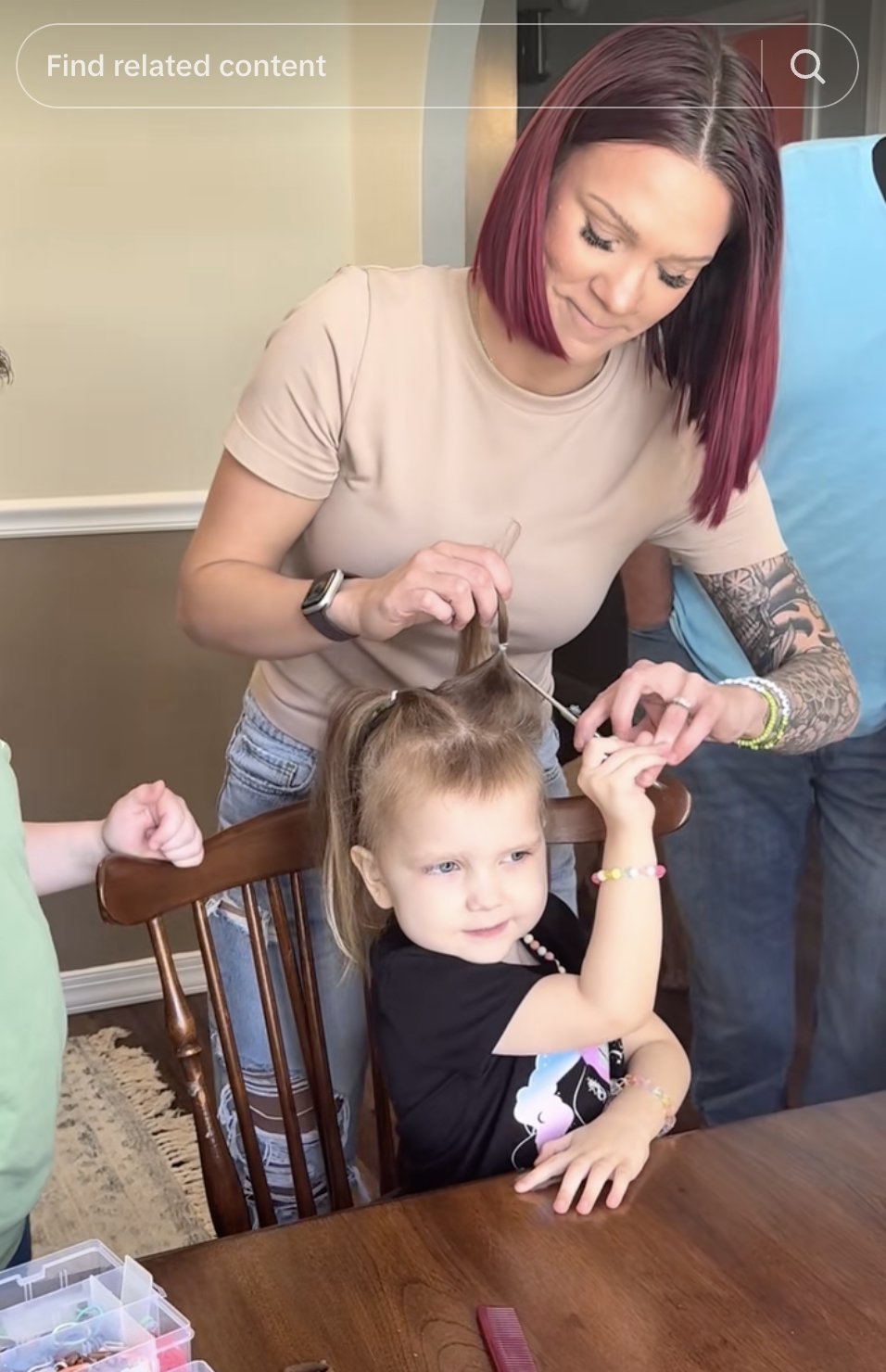
Miranda Aldridge with her daughter, Camryn, seen in a post dated March 18, 2025 | Source: Tiktok/@mjaldridge
As Camryn's clinic visits became part of daily life, Miranda and Bryan looked for a way to hold onto moments that still felt normal. Between medical charts and treatment cycles, Miranda started posting simple updates on Facebook, just one good thing each day.
Sometimes it was a photo, other times a note about something small that had gone right. Eventually, she expanded those posts to TikTok and Instagram. With a background in teaching, Miranda already had some followers.
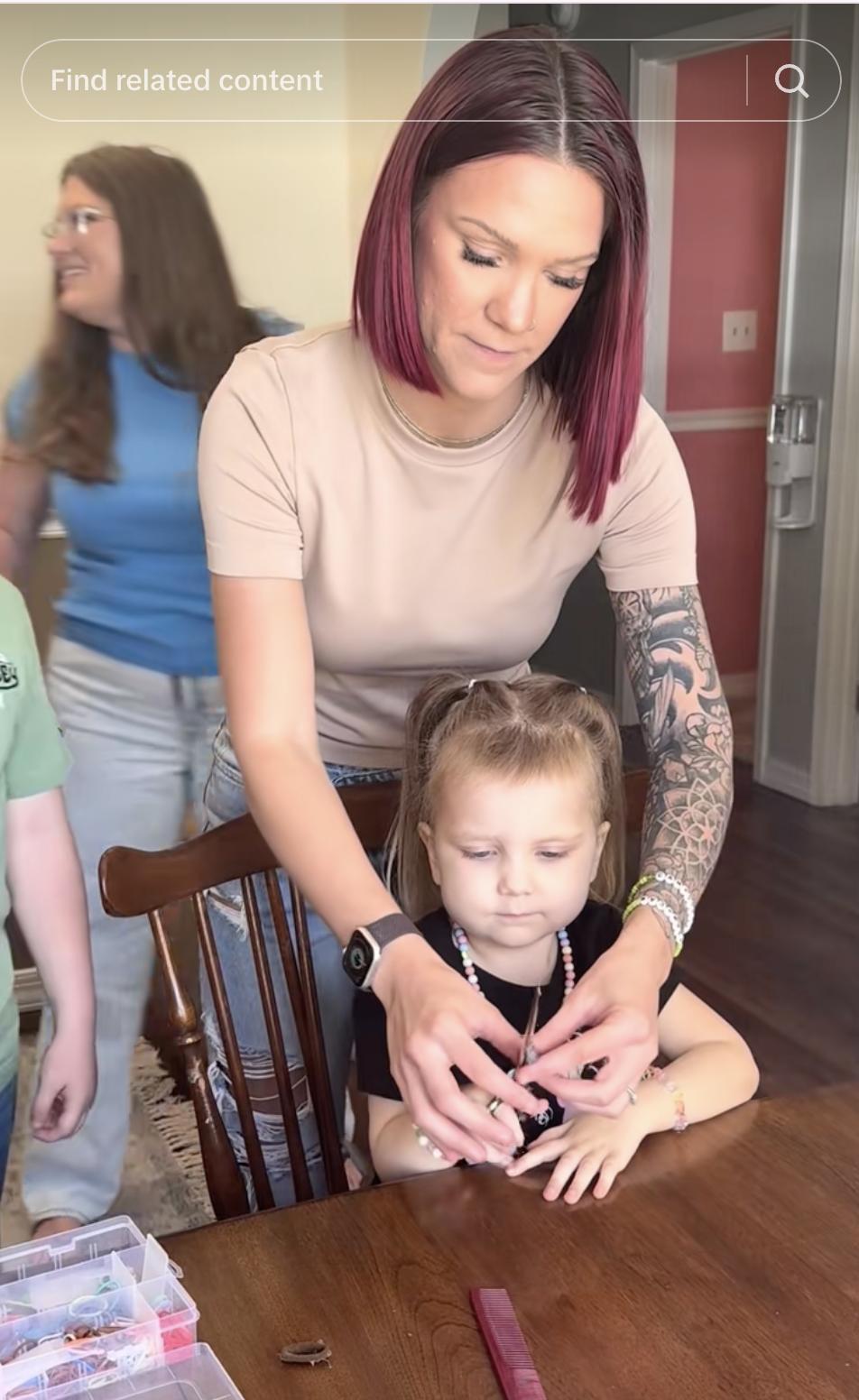
Camryn and Miranda Aldridge, seen in a post dated March 18, 2025 | Source: Tiktok/@mjaldridge
Now, she used those platforms to share clips of their new reality: Camryn coloring during appointments, laughing between tests, or smiling through tough days. Some videos were joyful, others captured quiet struggles, but each one offered an honest glimpse into what their family was living through.
People dropped off meals, sent gifts for Camryn, delivered care packages, and offered prayers.

Emotional Haircut for a brave cancer fighter, Camryn Aldridge, dated March 18, 2025 | Source: Tiktok/@mjaldridge
The videos found an audience. Thousands began to follow, and engagement grew. Around December 2024, Camryn's hair started to thin. Miranda and Bryan had tried to prepare her. They read storybooks that featured kids in treatment and pointed out other children at the clinic who had already lost their hair.
They explained that the medicine helping her would also cause this change, but that her hair would eventually grow back. Soon, strands were showing up on Camryn's pillow. She could slide her fingers through her hair and watch it come loose.
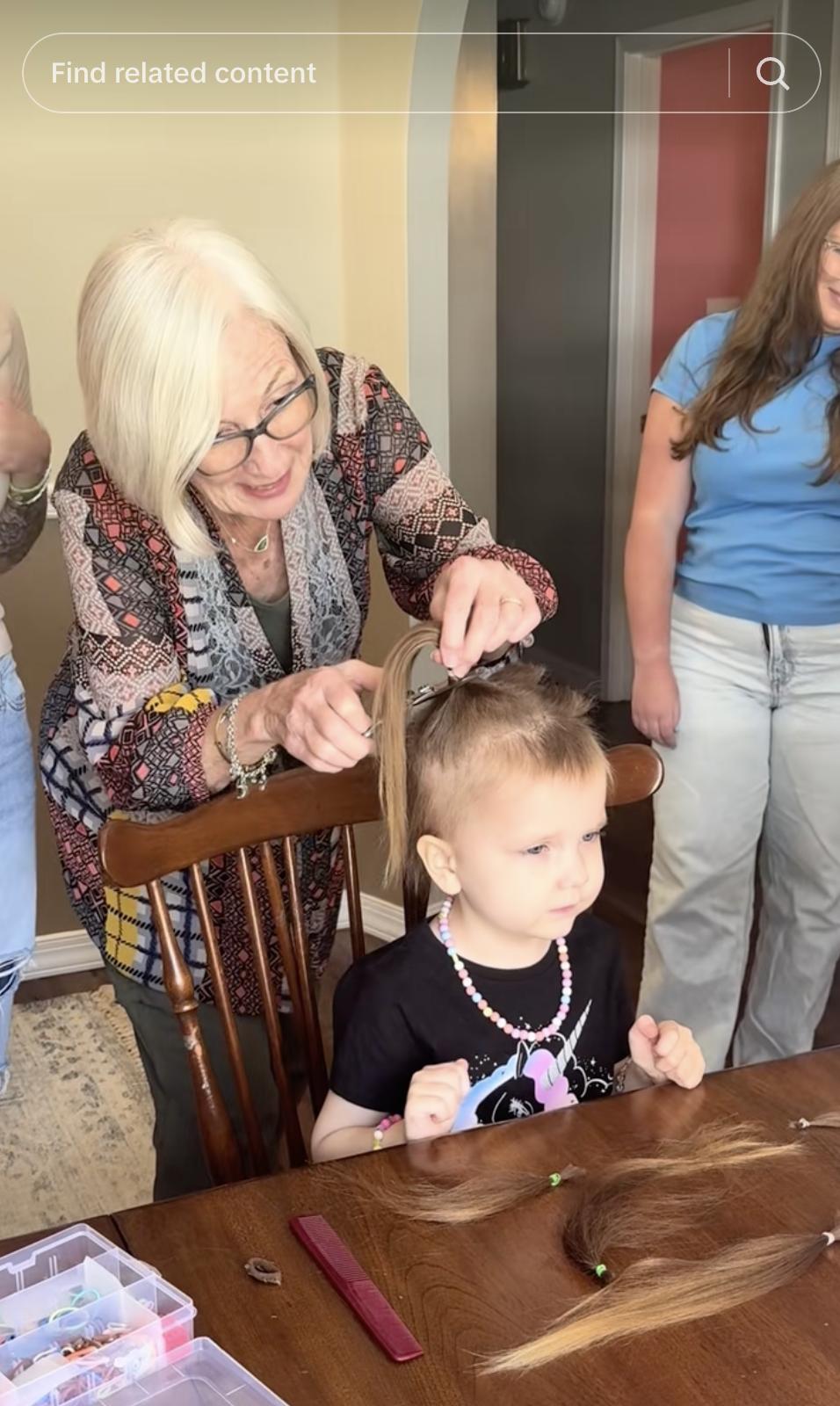
Camryn gets a hair cut, as seen in a post dated March 18, 2025 | Source: Tiktok/@mjaldridge
That's when Miranda saw a TikTok that caught her attention. In it, a woman named Carly, recently diagnosed with breast cancer, sat in a salon chair as friends and family took turns cutting sections of her hair. The act was intimate, symbolic, and full of care.
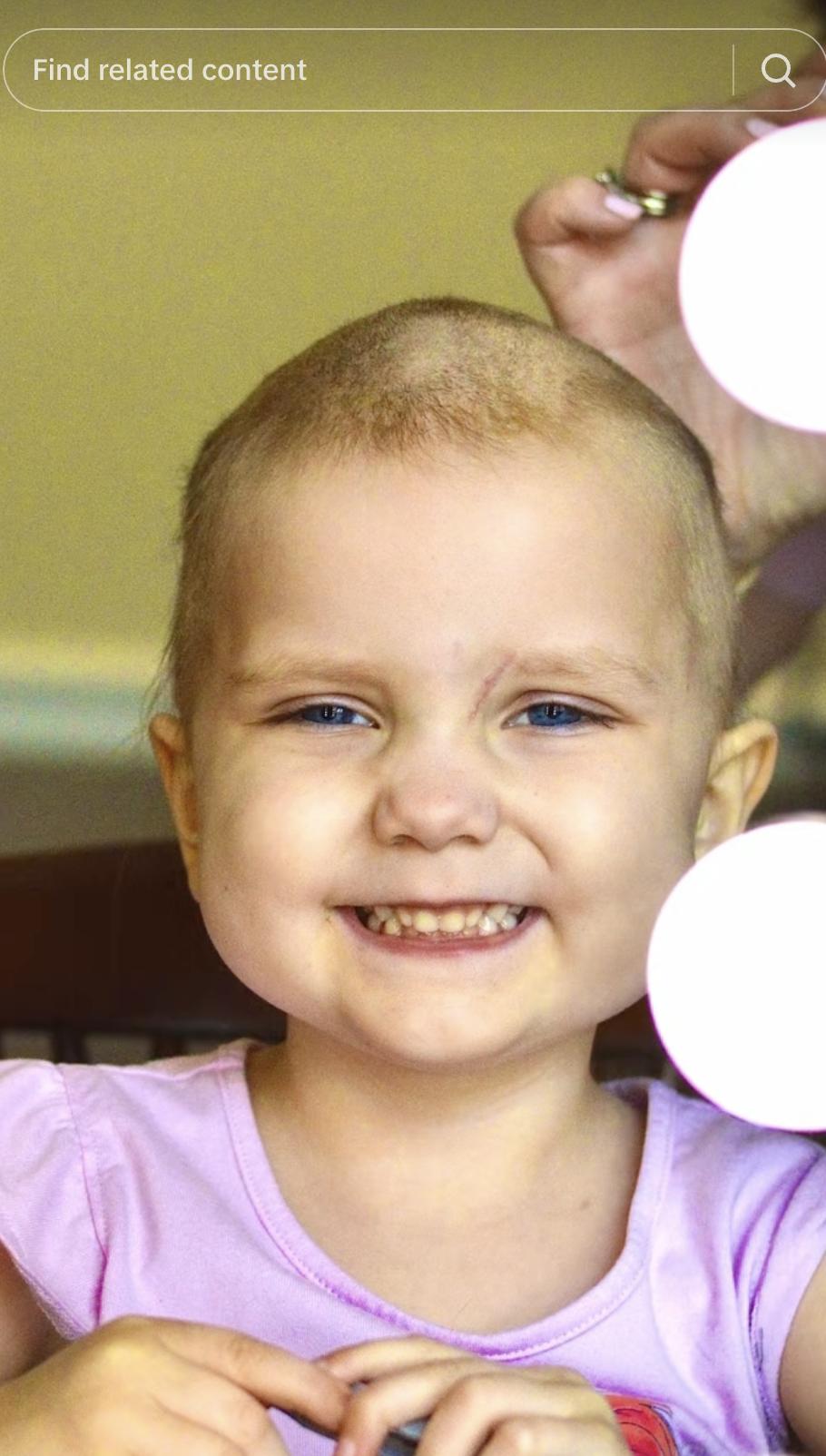
Camryn's hair transformation as seen in a post dated March 18, 2025 | Source: Tiktok/@mjaldridge
"I lost it," Miranda said. When she showed the video to Camryn, her daughter lit up. "She said, 'Mom, I want to do that. I want you to cut my hair. I want Dad to cut my hair. Can Bubba cut my hair?' She just ran with it."
At first, Miranda hesitated. Letting Camryn decide something so personal at such a young age wasn't easy. But she kept bringing it up, especially as her fourth birthday approached. A friend who had gone through cancer offered to take professional photos of the haircut.
As Camryn's story spread online, support poured in, not only from strangers across social media but from the community closest to home. In Palatka, neighbors, friends, schools, and churches rallied around the Aldridge family. People dropped off meals, sent gifts for Camryn, delivered care packages, and offered prayers.
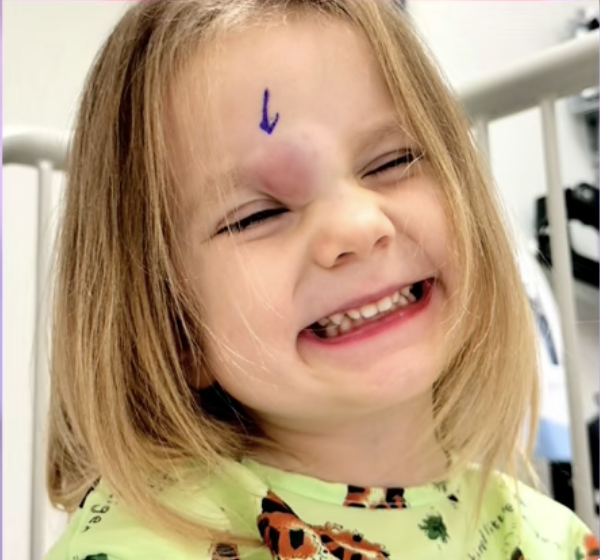
Camryn smiles at the camera, seen in post dated April 6, 2025 | Source: Tiktok/@mjaldridge
In those first critical weeks, that support made a real difference. Miranda was able to take time off from teaching without worrying about logistics. Fundraisers were organized. A local T-shirt drive was launched to raise money for medical costs. The family, overwhelmed but grateful, tried to say yes to every kind gesture. Miranda said:
"It's hard to accept being on the receiving end of so much support, but it's important to remember, you can always pay it forward. We've felt that very strongly."
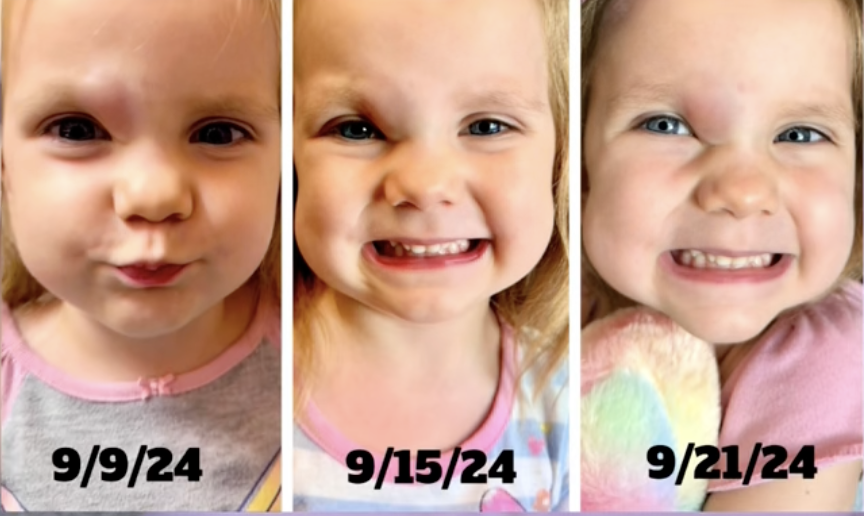
Pictures of Camryn at different stages of treatment, dated April 6, 2025 | Source: Tiktok/@mjaldridge
Over time, those acts of kindness began to shape something larger. The family launched a nonprofit project, inspired by Camryn's experience and spirit. The organization, still in its early stages, began selling custom-designed T-shirts, using the proceeds to support families navigating similar medical journeys.
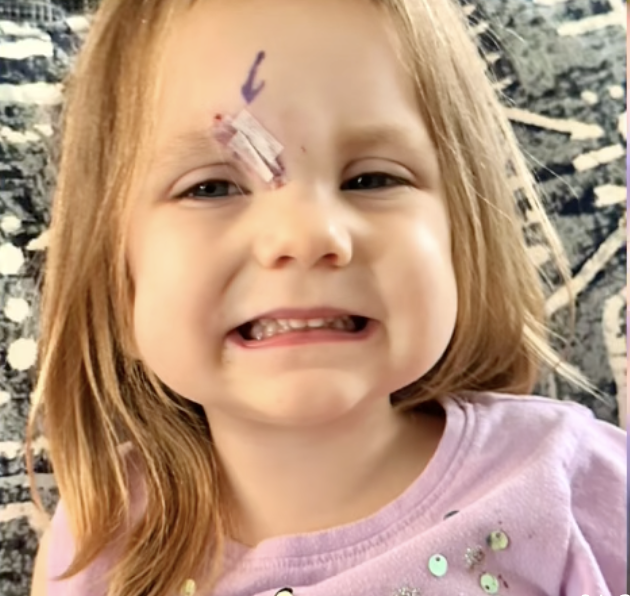
Camryn, seen in a clip dated April 6, 2025 | Source: Tiktok/@mjaldridge
The designs were directly inspired by Camryn: her colors, her phrases, her strength. As more people followed her story online, messages began coming in from all over. Some were from pediatric nurses or young adults who had once been patients themselves.
Others were from parents, some whose kids were already in treatment, and others who had just received a diagnosis. One message hit especially close to home. A mother had reached out after her daughter was diagnosed, not long after Camryn. Their timelines were close, and their daughters were around the same age.

Camryn seen in a post dated April 6, 2025 | Source: Tiktok/@mjaldridge
Though they lived in different states, the two moms kept in touch. They swapped stories, compared notes, and checked in regularly, sometimes just to say, "I get it." Miranda said, "We just clicked. I've been able to offer her advice, and she's been such a great listening ear for me, too."
Seeing another child go through it with confidence made the experience seem less overwhelming.
Their daughters began FaceTiming. For Camryn, seeing another little girl with a port was a turning point. It made everything a little less scary. She could talk to someone who was also going through treatment, someone who truly understood what it felt like.
The other mom later told Miranda that watching Camryn's haircut video helped her daughter feel more prepared. Seeing another child go through it with confidence made the experience seem less overwhelming. It gave her something to hold onto.
For Miranda, that connection meant more than any viral moment ever could. "Those connections have been... I don't even know how to describe them," she shared. "Unbelievable. That's what's made this journey feel a little less heavy."
Throughout the difficult experience, Miranda, Bryan, and Camryn have found ways to hold steady. They've documented their journey, built a community around it, and reached other families walking the same road. Although the story hasn't ended, they no longer feel like they're walking it alone.
The information in this article is not intended or implied to be a substitute for professional medical advice, diagnosis or treatment. All content, including text, and images contained on news.AmoMama.com, or available through news.AmoMama.com is for general information purposes only. news.AmoMama.com does not take responsibility for any action taken as a result of reading this article. Before undertaking any course of treatment please consult with your healthcare provider.
